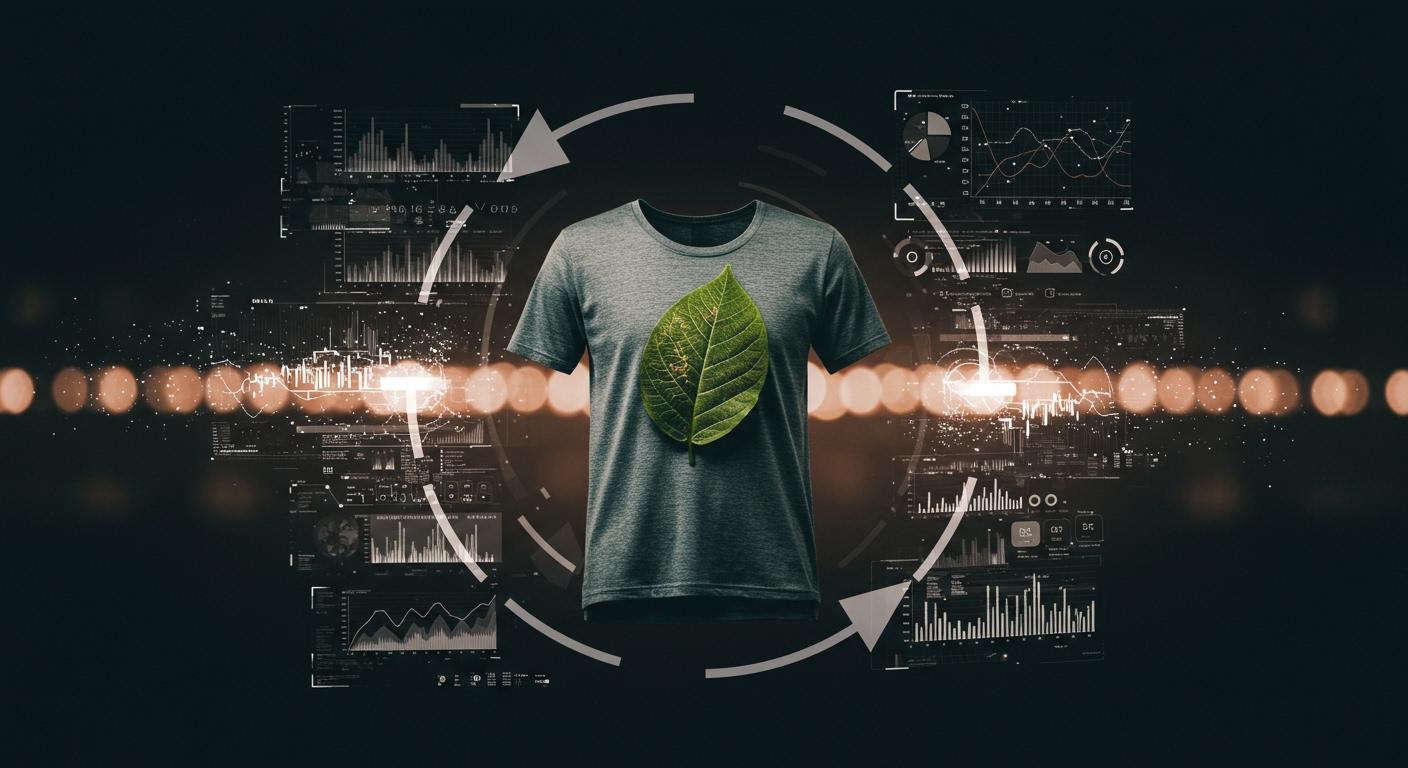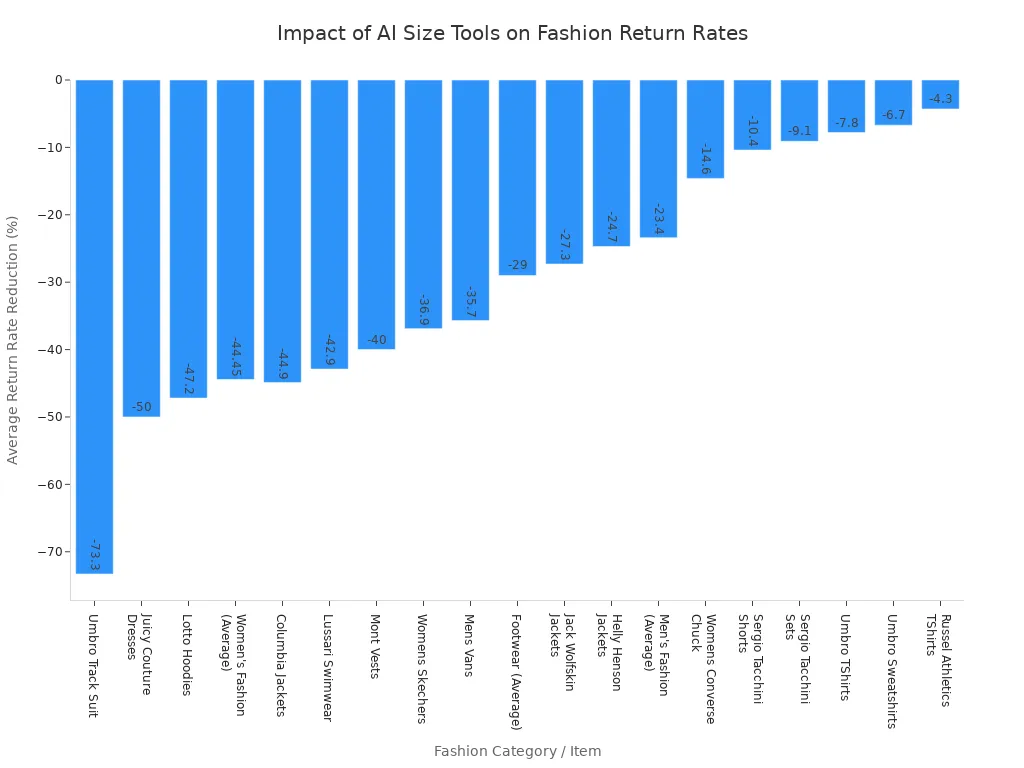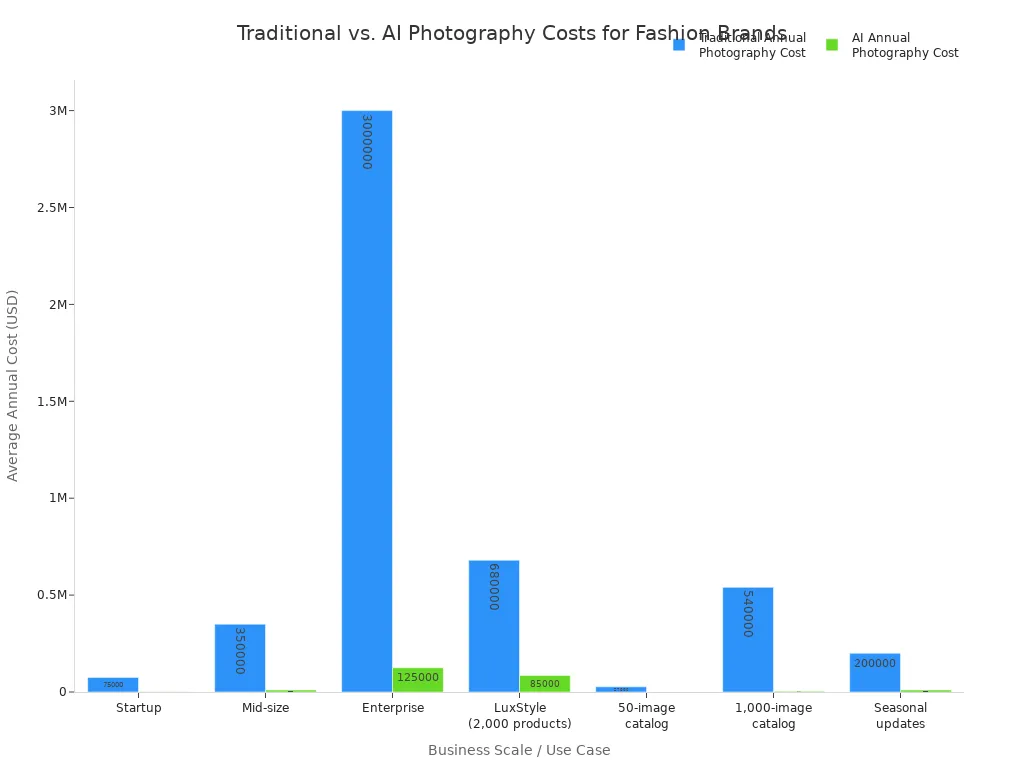
Artificial intelligence is no longer a buzzword. AI is a practical tool revolutionizing how brands measure their impact on the environment. This is critical in an industry facing immense challenges.
The fashion sector generates 92 million tonnes of textile waste annually.
AI-assisted lifecycle analysis provides a comprehensive, data-driven view of a garment's entire journey. This AI technology makes sustainable design a reality. It shifts sustainable fashion from vague claims to precise, actionable insights. AI empowers brands to make smarter, sustainable decisions. AI is key for environmental sustainability. AI helps make sustainable design a core part of fashion sustainability. This sustainable AI approach improves overall sustainability. A sustainable future needs AI.
Understanding AI-Assisted Lifecycle Analysis
From Traditional Methods to AI
Traditional Lifecycle Analysis (LCA) maps the environmental impact of a piece of clothing. This method tracks a product from raw material to disposal. However, these traditional reports are often static and use broad averages. This approach fails to capture the specific details of modern clothing production. The complexity of textile supply chains and a lack of complete data present major barriers. These challenges make it difficult for brands to get a truly accurate picture of their impact on the environment.
Artificial intelligence (AI) is changing this entire process. AI enhances the analysis of a clothing item's footprint with incredible speed and precision. AI systems process vast, complex datasets that are impossible to manage manually. This technology helps create a more sustainable clothing industry. AI makes the goal of sustainability more achievable for every brand. This powerful AI technology provides a clear path toward sustainable operations.
The Power of Data in Green Fashion
The true strength of ai-assisted lifecycle analysis lies in its use of data. AI platforms connect directly to a company's internal systems. They pull real-time information on materials, manufacturing, and logistics. This creates a dynamic and accurate view of the entire clothing lifecycle. AI uses machine learning to intelligently fill data gaps, replacing vague industry averages with precise estimates based on millions of data points from similar products. This approach to sustainability is far more effective.
This level of detail empowers brands to make smarter, sustainable choices. For example, an AI tool can compare thousands of material options to find the one with the lowest impact. AI helps companies build a credible sustainable fashion brand. Ultimately, ai-assisted lifecycle analysis turns sustainability goals into data-driven actions, protecting the environment. This sustainable approach is the future of clothing manufacturing.
AI's Role Across the Clothing Lifecycle

Artificial intelligence provides powerful tools at every stage of a garment's journey. From the initial concept to its final disposal, AI helps brands make targeted, sustainable choices. This technology transforms the entire value chain, making sustainable clothing design a practical reality.
Sustainable Sourcing and Design
The journey to a sustainable garment begins with its design. AI platforms give designers the data they need to make better choices from the start. These tools evaluate the environmental footprint of thousands of different textiles. They recommend low-impact and eco-friendly materials that align with a brand's sustainability goals. This data-driven approach moves sustainable design beyond guesswork.
For example, some AI tools help brands improve their design for sustainability.
- Platforms like CircKit Design offer insights into fabric compositions.
- This AI technology suggests design improvements that minimize waste.
- It helps optimize fabric selection by analyzing environmental impact, durability, and aesthetics.
Beyond material selection, AI also tackles fabric waste. AI algorithms optimize cutting patterns for clothing. This process minimizes the amount of scrap fabric left over, a concept known as scrap reduction. Better design means less waste before the clothing is even made. This is a core part of sustainable clothing design.
Eco-Friendly Manufacturing
The manufacturing phase traditionally consumes vast amounts of energy and water. AI introduces a new level of efficiency to factory floors. AI-driven monitoring systems, paired with smart sensors, track resource consumption in real time. They identify opportunities to reduce energy use and optimize water-intensive processes like dyeing. For instance, the company Ekoten Tekstil uses a real-time AI system to find and fix textile defects early. This proactive method reduces the need for re-dyeing, which saves significant amounts of water.
Visual inspection is another area where AI creates a major impact. AI-powered systems use high-resolution cameras and machine learning to spot product defects. This technology is faster and more accurate than human inspection.
AI can spot fabric snags as small as 0.1 millimeters and faint color deviations that the human eye might miss. While human inspectors can miss up to 30% of defects, AI systems maintain accuracy rates above 90% without fatigue.
This automated quality control offers several benefits for sustainable production:
- It identifies subtle defects that human inspectors often miss.
- It allows for immediate correction of production errors.
- It tracks quality trends to identify the root causes of defects.
By catching flaws early, AI prevents flawed materials from becoming finished clothing items that would otherwise be discarded. This reduces waste and improves the overall sustainability of the manufacturing process.
Smart Logistics and Retail
Logistics and retail present major challenges for sustainability, from shipping emissions to overproduction. AI offers smart solutions to address these issues. Brands like H&M use AI to optimize shipping routes, which reduces fuel consumption and carbon emissions.
Perhaps the biggest contribution of AI in this stage is tackling overproduction. The fashion industry wastes billions of clothing items each year due to inaccurate demand forecasts. AI changes this by analyzing huge datasets.
- AI tools like Prediko help brands like Kate Hewko improve inventory efficiency by 40%.
- Retailers such as Zara use AI to analyze social media trends and global fashion events for agile inventory management.
- Accurate forecasting prevents excess stock, which directly reduces waste and improves sustainability.
AI also helps reduce the high volume of returns, a major source of emissions and waste. AI-powered tools give customers precise size recommendations. This ensures a better fit and reduces the likelihood of a return. European tests show these tools can lower return rates by up to 30%. The impact varies by clothing item but shows a clear trend toward waste reduction.
| Category/Item | Average Return Rate Reduction |
|---|---|
| Women's Fashion (Average) | -44.45% |
| Men's Fashion (Average) | -23.4% |
| Footwear (Average) | -29% |
| Umbro Track Suit | -73.3% |
| Juicy Couture Dresses | -50% |

Fewer returns mean less reverse shipping, less packaging waste, and fewer garments sent to landfills. This makes the retail experience more sustainable for both the brand and the environment.
Circularity and End-of-Life
A garment's life does not end after its first sale. A circular economy aims to reuse, recycle, or upcycle clothing to eliminate waste. The ai-assisted lifecycle analysis process supports this goal. AI technologies are essential for creating an effective circular system for clothing.
Sorting textiles for recycling is a complex task. Many modern fabrics are blends of different materials. AI-powered systems use technologies like Near-Infrared (NIR) spectroscopy to identify a fabric's chemical composition in seconds.
- Companies like Sortile and Refiberd use AI and hyperspectral cameras for rapid and precise sorting.
- These systems can achieve accuracy rates as high as 96%.
- Robotic arms then automatically separate clothing into categories for efficient recycling or reuse.
AI also powers the growing resale market and brand take-back programs. Platforms like Circular use AI to automate the resale process. AI algorithms suggest optimal pricing based on real resale data. They also manage logistics for returned items, routing them to the correct facility for inspection, repair, or recycling. This makes it easier for brands to participate in the circular economy and extend the life of their clothing. This approach to sustainable clothing design closes the loop, turning old garments into resources for the future.
Key Benefits for Green Brands

Adopting AI-assisted lifecycle analysis offers fashion brands a powerful competitive advantage. This technology moves sustainability from a marketing claim to a core operational strategy. The benefits are clear, measurable, and transformative for any brand committed to fashion sustainability.
Achieving Unprecedented Accuracy
Traditional environmental assessments often rely on manual data entry and industry averages. This process is slow and prone to human error, which can lead to flawed conclusions. AI revolutionizes this by delivering a new standard of precision. AI algorithms process huge datasets, automate data collection, and validate information from multiple sources. This ensures the final analysis is both consistent and reliable.
AI enhances impact measurement in several key ways:
- Automated Data Handling: AI systems automatically extract and clean data, reducing manual effort and improving accuracy.
- Intelligent Data Gap Filling: AI uses predictive models to estimate missing information, creating a more complete and reliable assessment.
- Consistent Methodology: AI applies standardized emissions factors automatically, ensuring calculations are consistent across thousands of products.
- Continuous Learning: AI models learn over time, constantly improving the precision of environmental impact predictions.
Brands are already using AI to achieve greater accuracy in their operations. This technology helps them make more informed, sustainable decisions.
| Brand | AI Application | Impact on Accuracy |
|---|---|---|
| Heuritech | AI-driven trend forecasting | Improves accuracy in predicting consumer demand, which helps optimize collections and reduce overstock. |
| The RealReal | AI tools for authentication | Enhances accuracy in identifying counterfeit items, ensuring the integrity of the luxury resale market. |
This level of accuracy is fundamental for any credible sustainability program.
Driving Smarter Decisions
Accurate data empowers smarter, more sustainable choices at every step. AI-assisted LCA provides real-time feedback that allows designers and supply chain managers to see the environmental impact of their decisions as they make them. This turns the design process into a dynamic, interactive tool for sustainability.
With AI, brands can:
- Instantly check material choices against lists of low-impact options.
- Flag long shipping routes to reduce transport emissions.
- Ensure a new clothing design meets recyclability goals before production begins.
- Automate sustainability checks to monitor designs against eco-criteria continuously.
This data-driven approach allows for immediate fixes. A designer can see how switching from conventional cotton to an eco-friendly alternative affects the garment's total footprint. This capability transforms the entire approach to sustainable design, making it proactive instead of reactive. AI gives teams the insights they need to build sustainability into the DNA of their clothing.
Boosting Credibility in Sustainable Fashion
Consumers are increasingly skeptical of vague sustainability claims. The fashion industry faces a trust deficit, with many shoppers demanding proof of a brand's eco-friendly promises. AI provides the hard data needed to build that trust through genuine traceability and transparency.
In 2022, H&M faced a class-action lawsuit over its "Conscious Collection." The lawsuit alleged the brand marketed products as sustainable without providing sufficient verifiable evidence. This case highlights the growing legal and reputational risks of unsubstantiated claims.
By using AI to track and report on their environmental footprint, brands can replace marketing buzzwords with verifiable facts. This commitment to transparency builds long-term customer loyalty. Companies that invest in transparent reporting see significant returns.
| Initiative/Company | Impact on Growth and Loyalty |
|---|---|
| Brands with strong transparency (2020-2023) | 15% increase in market share |
| Everlane’s “Radical Transparency” | 40% year-over-year growth, 90% customer retention |
| Levi Strauss & Co. (supply chain transparency) | 22% reduction in operational costs in two years |
AI-powered reporting makes this level of transparency scalable. It allows brands to confidently share their sustainable fashion journey with customers, building a credible and trustworthy reputation.
Realizing Cost and Resource Savings
A common misconception is that sustainability is expensive. AI-assisted LCA proves that resource efficiency and cost savings go hand in hand. By optimizing processes and reducing waste, AI directly improves a brand's bottom line. A sustainable business is an efficient business.
For example, AI dramatically reduces the costs associated with product photography, a major expense for fashion brands.

The savings extend far beyond marketing. AI delivers quantifiable financial benefits across the value chain:
- Reduced Material Waste: AI-optimized cutting patterns minimize fabric scraps, lowering material costs.
- Lower Energy Consumption: AI monitoring systems identify energy waste in factories, reducing utility bills.
- Fewer Returns: AI-powered sizing tools lead to fewer returns, saving money on reverse logistics and restocking.
- Eliminated Revision Costs: AI can generate unlimited design variations at no extra cost, while traditional changes can cost thousands.
Ultimately, AI helps brands use fewer resources to create better clothing. This makes the pursuit of sustainability not just an ethical choice, but a smart financial one.
Overcoming Implementation Challenges
Adopting AI-assisted lifecycle analysis offers immense benefits. However, brands must navigate several key challenges to implement this technology successfully. A successful sustainable design strategy requires careful planning.
The High-Quality Data Requirement
The effectiveness of any AI system depends on the quality of its data. Many fashion brands struggle to collect reliable information for a sustainable clothing design. The industry's complex and fragmented supply chains make data gathering difficult.
Brands often rely on broad industry averages instead of specific data from their own processes. This can lead to less accurate impact measurements for a sustainable clothing design. Suppliers may also lack transparency about their resource use, creating further data gaps.
To ensure data integrity, companies need robust governance frameworks. Implementing principles like FAIR (Findable, Accessible, Interoperable, Reusable) helps organize data for AI systems. A strong framework is essential for any sustainable AI initiative. This ensures the AI has the right information for a better clothing design.
Initial Technology and Cost Barriers
The initial investment in AI technology can seem daunting, especially for smaller businesses. However, the landscape is changing. The rise of affordable hardware and scalable AI solutions is making this technology more accessible.
- Low-cost sensors and cameras reduce the capital expense for data collection.
- Edge devices process data locally, lowering network infrastructure costs.
- Cloud-based AI platforms offer scalable options that grow with a brand's needs.
Companies can start with pilot projects to demonstrate benefits before a full rollout. This approach helps manage costs and makes AI a more affordable path toward sustainable operations. The right AI can improve the entire clothing design process.
The Need for Specialized Expertise
Implementing AI requires a team with specialized skills. A successful sustainable program needs professionals who understand both AI and sustainability. Key roles require expertise in data analysis, machine learning, and sustainable technology. This knowledge is crucial for using AI to reduce waste and optimize clothing design.
Many companies face a talent gap in these areas. The solution is to cultivate AI fluency throughout the organization.
- Designers must learn to use generative AI tools.
- Merchandisers need to become AI-augmented data strategists.
- A universal understanding of AI capabilities is necessary across the workforce.
This commitment to training equips the team for a new operational paradigm. It ensures the entire organization can contribute to the brand's sustainability goals and create truly sustainable clothing. The future of sustainable fashion depends on this blend of human expertise and powerful AI.
AI-assisted lifecycle analysis transforms sustainable fashion. This sustainable AI technology replaces guesswork with data-backed action. True sustainability is now achievable. AI empowers brands to pinpoint and reduce their impact. Sustainable AI helps from fabric choice to recycling programs. This sustainable AI approach improves overall sustainability. A sustainable future needs AI. Sustainable AI is key for environmental sustainability.
Support brands that use sustainable AI for transparency. Stay informed about how this sustainable AI innovation paves the way for a greener sustainable fashion future. This sustainable AI makes sustainability a reality.
FAQ
Is AI technology too expensive for small fashion brands?
No, AI is becoming more affordable. Many companies offer scalable, cloud-based AI solutions. These platforms allow smaller brands to pay for only the services they need. This makes advanced technology accessible without a large upfront investment.
Does AI replace human designers in the creative process?
AI does not replace human creativity. Instead, AI acts as a powerful assistant. It provides designers with data on material impacts and waste reduction. This information empowers them to make more sustainable choices while still leading the creative vision.
How do brands ensure data privacy when using AI?
Brands implement strong data governance policies to protect information. They use secure platforms and control data access strictly. This ensures that sensitive supply chain and customer data remains confidential while the AI performs its analysis.
The AI systems analyze data patterns without exposing raw, sensitive information. This protects both the brand and its partners.
What is the single biggest advantage of using AI for LCA?
The primary advantage is data-driven accuracy. AI replaces guesswork with precise, verifiable metrics on environmental impact. This allows brands to make targeted improvements across the supply chain. This AI-powered insight builds credibility and drives real sustainable change.
See Also
Eco-Friendly AI: Revolutionizing Fashion for a Sustainable Global Future
Intelligent AI Solutions: Optimizing Fashion Returns for Enhanced Efficiency
Forecasting Fashion: AI Analytics Harmonizes Supply with Consumer Demand
Apparel Evolution: Strategic Paths from Production to Brand Identity
Future of Fashion: AI Sensors Transforming the 2025 Supply Chain